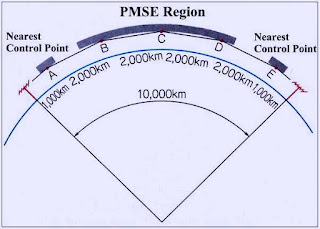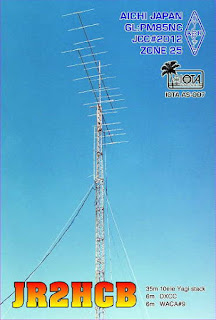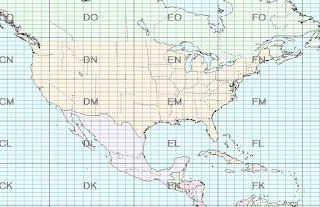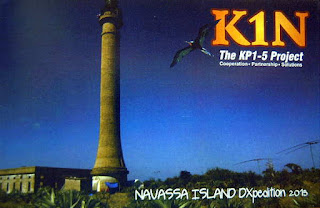Posts Tagged ‘Sporadic-E’
 6m SSSP JA’s
6m SSSP JA’s
 |
| JA7DYN's Station |
Six meters delivered a mid-afternoon surprise yesterday, with a brief opening between the west coast and Japan. It was one of those openings that would have been missed entirely, a few years ago.
At around 2300Z, JE1BMJ (Han), announced via the ON4KST 50MHz chat page that he would be CQ'ing towards North America on 50.090KHz. I was working at the bench with the receiver running in the background and took a moment to turn my 4el yagi towards Japan and put the receiver on frequency. Nothing was heard for several minutes when, as if a switch had been thrown, the frequency became alive with CW sending "... DX K". About 20 seconds later it started again, a CQ DX from JE1BMJ. It is amazing how often the band or a path will appear to suddenly open, in this case, at just the tail end of Kas's CQ ... not a whisper of anything before the very tail end. As I listened, his signal built from the initial 559 to 579 at which point I called and we exchanged signal reports.
I moved down the band and called CQ DX and was immediately called by several loud JA stations. Over the course of the short opening (just 15 minutes from start to finish), I worked the following stations in Japan:
JE1BMJ
JA1VOK
JR2HCB
JF1UMK
JAØRUG
JM1IGJ
JG1TSG
JHØKHR
JF1IRW
JA7DYN
JK1EXO
As mentioned earlier, this was an opening that would probably have been missed a few years ago, for several reasons. One factor is the growing use of the Internet to spot activity or stations that are actually on-the-air in real time. Another reason is the very short window of opportunity. Without stations looking, thanks to Han's QRV announcement, it is probable that nobody would have been pointing towards Japan at that time of the day ... but, more likely, the biggest reason is the exploitation of the SSSP path between NA and Asia that has become somewhat of a regular occurrence over the past several summers.
SSSP or Short-path Summer Solstice Propagation is the mechanism uncovered by JE1BMJ in 1999. In that year he discovered that his signals could be heard almost daily in many parts of Europe by transmitting on a regular evening schedule. He then turned his attention to North America, in the morning, and found much the same thing. Han continues to this day on a regular schedule each day and more often than not, works several stations in North America ... from both coasts and everything in between. He has even worked into Central America on SSSP.
SSSP is a summertime-only event in the northern hemisphere and relies on the scattered ice crystals found in the Polar Mesospheric Summer Echo region (PMSE), located about 88km above the ground, very near the same height as the E-layer.
 |
| courtesy: JE1BMJ |
Signals travel through the polar region and never touch the ground until the far end of the path is reached. In all probability, this is the same mechanism that west coast stations are able to work transpolar-Es into Europe during the summer. The season is short-lived (June/July) and openings can have weak rapidly fading signals or, as in yesterday's case, strong steady signals during the course of the opening. Openings can last from just a few minutes to several hours. Thanks to the Internet and real-time chat, most of these openings are no longer being missed.
Stations being worked via SSSP seem to be, for the most part, running high-power and / or large antenna systems. It is rare to work many of the 100 watt stations, although under good conditions, it does happen.
 |
| JR2HCB's 6m Yagi Stack |
 Vatican Magic
Vatican Magic
| courtesy: K7CW |
June 21st was one of the better days of this year's poor Sporadic-E season. Stations in the western part of North America had an early-morning opening to the Caribbean as well as to South America, when YV1KK was worked by stations in the PNW region.
Here's how it happened here. I hadn't been paying attention to it, but N5DG had worked HVØA. Somebody mentioned that HVØA was going to QSY to 50.078 and was going to be looking for NA. I thought this choice of frequency was odd because some Europeans are not authorized to use frequencies below 50.080. But, I decided to go down there and check it out, because doing that has often paid off (re the CYØX QSO which brought me to start doing this). The propagation to the Caribbean and northern South America was demonstrably quite good (I worked my first YV), so checking out this European spot made even more sense.
I swung my beam up to a heading that I thought was good enough for Italy and tuned down on .078. Fortunately, there were no beacons coming through on that frequency, so I could concentrate on digging out any weak signal that was there. I slowly tuned around .078 and, for a while, heard nothing. After a few minutes, I began to sense that there was some tonal quality to the noise (musical noise). It was just there as no more than a hint, but I slowly tuned it so that it matched the frequency of my CW sidetone. I hoped that the other station (if there was one) would also have his filters set the same way. When I thought I had it about right, I switched in all my CW filters to the tightest setting (50 Hz) on both my transceiver and also my JPS NIR-12 outboard DSP filter. When I did this, the signal to noise ratio improved so well that I immediately started copying, "CQ NA CQ NA de HVØA HVØA" He was solid copy, but I needed those tight filters. I got his attention on the first call! He called me back using K8CW and gave me 599. I'm sure he was receiving me well, but probably didn't believe I was a 7. He kept calling me K8CW and I kept correcting him. I gave him a 599, too, but it was just a jerk-knee response that someone might do upon being the object of a miracle. But he was solid copy. After our QSO, I stopped hearing him. I logged him at 1631Z. The spotting record shows that N5DG and K7CW were the only North American stations to work HVØA on June 21 on 50 MHz. So, that's my side of the story.
| courtesy: K7CW |
No magic for me that day but kudos to Paul and his fine station, as well as to Francesco, for the heads-up operating and being on top of the short propagation window that morning!
 |
| courtesy: K7CW and https://www.qrz.com/ |
These are the moments that 6m diehards live for, especially those on the west coast ... reminding us once again why the 'magicband' deserves its well earned moniker.
 A New Country and Some 2m Es
A New Country and Some 2m Es
The summer propagation doldrums, as well as my roof reshingling projects, received a short respite this week with the arrival of a new DXCC QSL for 160m. The K1N card (Navassa Island Expedition) was received for my CW QSO this past winter. The card brought my 160m DXCC total to 155 worked and confirmed while adding one more to my overall all-band total of 336 / 336.
Sunday afternoon brought a rare and welcome 2m sporadic-E opening. Signals on 6m towards Colorado quickly rose from a normal 'S9' to ear-shattering S9 + 30-40db with one signal putting the S-meter of my IC-756PROIII hard against the right pin and completely blanking the bandscope's lower regions ... I have only seen this happen once before, when beaming semi-local VE7XF while he is running high-power.
I immediately activated my Es MUF receiver (Icom R-7000), tuned to an empty FM frequency and squelched. Not long after, the squelch broke with a strong signal also from Colorado and several more throughout the band. It is difficult to ID FM signals as they rarely identify except at the top of the hour.
After several CQ's on 144.200 (9el yagi and 150 watts) aimed to the SE, W9RM in Colorado popped-up briefly with an S9 signal and was quickly worked before he faded. Unfortunately, either due to lack of activity or fast-deteriorating conditions, his was the only signal heard. In terms of 'quality' of the opening, it was poor, but any 2m Es is always exciting.
I once had a two-hour 2m Es opening to southern California and worked 32 Californians on 2m SSB before conditions faded ... it would be nice to see that once again. One of the fellows I worked that night had just set up his new 2m transceiver and, not being familiar with 2m propagation, told me 'I'll look for you again tomorrow night'. I told him that he could look for me for the next 20 years and he'd likely not hear me ... that opening was 32 years ago!
Let's hope we get some more 2m Es before the season ends as it is one of the most exciting propagation experiences there is.
 Summer Solstice Magic
Summer Solstice Magic
As I write this on Sunday evening, June 21st, the magic band has been open here for over 16 hours straight and shows no signs of slowing down! What has been one of the poorest Sporadic-e seasons in memory, did not disappoint today, on what should theoretically be the peak day of the season.
A loud NØLL in Kansas was the first station heard this morning at around 0600 local time but I suspect the band had been open even earlier, judging by the strength of the signals. It didn't take long for the band to stretch out further and not too much later, signals from the Caribbean were making it into southern British Columbia, as well as many parts of North America.
At times the band seemed as crowded as 20m CW during the Sweepstakes as so many of the CW stations congregate in the 20KHz slot just below 50.100MHz. Before breakfast, the following stations were in the log:
ZF1EJ Cayman Islands
9Y4D Trinidad
YV1KK Venezuela
6Y5WJ Jamaica
KP4EIT Puerto Rico
XE2MVY Mexico
XE2X Mexico
WP3C Puerto Rico
NP4BM Puerto Rico
Around 10 am local time, the VA5MG beacon was suddenly heard pounding away ... often a good sign that propagation may be going 'polar'. Sure enough, stations to my south (Oregon and Washington) started to hear and work Europe. I was lucky enough to hear what can only be described as the contact of a lifetime, when K7CW (about 140 miles to the south) was heard working HVØA, the Vatican!! Paul was apparently in the sweet spot of the moment and his efficient homebrew array was up to the job. Over the next hour or so, the European propagation swung wildly between W7 and W6 as well as points to the east. The only Europeans that I heard were two Italian stations, briefly hitting 559 but unable to hear me. Johnny, KE7V (and also the brother of K7CW), about 40 miles to my south, managed to work both stations ... it seems that we were both just on the northern edge of the teasing footprint.
At times, several in band 'growly' carriers with polar flutter were heard as well as weak signals from some of the 49MHz videos still operating in central Europe.
It will be interesting to see if we have a repeat of this prop tomorrow (Monday) but I rather suspect much of this was the result of two well-placed solar flares earlier in the morning and will not be repeated ... I hope I'm wrong!
Impact from the flares plus a slower moving one is expected later today.
A loud NØLL in Kansas was the first station heard this morning at around 0600 local time but I suspect the band had been open even earlier, judging by the strength of the signals. It didn't take long for the band to stretch out further and not too much later, signals from the Caribbean were making it into southern British Columbia, as well as many parts of North America.
At times the band seemed as crowded as 20m CW during the Sweepstakes as so many of the CW stations congregate in the 20KHz slot just below 50.100MHz. Before breakfast, the following stations were in the log:
ZF1EJ Cayman Islands
9Y4D Trinidad
YV1KK Venezuela
6Y5WJ Jamaica
KP4EIT Puerto Rico
XE2MVY Mexico
XE2X Mexico
WP3C Puerto Rico
NP4BM Puerto Rico
 |
| courtesy: https://www.google.ca/maps |
At times, several in band 'growly' carriers with polar flutter were heard as well as weak signals from some of the 49MHz videos still operating in central Europe.
It will be interesting to see if we have a repeat of this prop tomorrow (Monday) but I rather suspect much of this was the result of two well-placed solar flares earlier in the morning and will not be repeated ... I hope I'm wrong!
 Summertime CBer
Summertime CBer

As much as I hate to admit it, for a few short weeks every summer, I become ... get ready for it now ... a CBer! Now I'm not talking about what might typically come to mind when thinking about CBers ... for me it's more of a love-hate relationship. You see, the 27MHz CB band, and 27.385MHz in particular, happens to make one of the best indicators of Sporadic-e openings on the face of the planet. Unlike the vast empty wasteland that 10m becomes during the summer, the 11 meter band is jam-packed full, with thousands of operators ... and some days it seems as if they are all on the 27.385 MHz (LSB) calling frequency.
With my receiver quietly running in the shack, the frequency can suddenly jump to life, with hundreds of stations calling each other in a matter of seconds. Sometimes it's like a switch has suddenly been thrown to 'ON'. This is not too hard to understand as the present suspected cause of Es is sudden high speed wind-shear within the E-layer. Have a quick listen to what the calling frequency can suddenly sound like:
Now the beautiful thing is that strong Es on 11 meters usually heralds the possibility of 6m also opening via the same mode ... usually 30 minutes or so later if it's going to happen. Often a CQ on a seemingly 'dead' 6m band in the direction of the 11m Es, will produce a response from an equally surprised operator at the other end.
I don't think I've ever heard Es on the 6m calling frequency without hearing Es on 11 meters beforehand. It's been my experience that the band always opens from low to high, in terms of frequency, so it just makes sense to listen lower (11m) to get a heads-up for what is likely soon to follow on the magic band. As well, knowing that there is 'zero' Es on 11m, can let you rest assured that nothing will be happening on 6m via Es ... at least for the time being.
If you haven't already tried it and have a second receiver that can be put to use as an 'Es-monitor', you might be pleasantly rewarded. Even though knowing that the band will soon open might rub a bit of the magic away, I think it's still well worth it!
 Where’s The Magic?
Where’s The Magic?
 |
| courtesy: http://www.dxmaps.com/ |
Most 6m diehards understand that the cause of summer Es is high-speed wind shear events, way up in the E layer region but a new theory suggests otherwise:
 |
| courtesy: nz3m.com |
 The Boys of Summer
The Boys of Summer
 This past week, Les Rayburn (N1LF), compared his yearn for the start of spring baseball to the late spring return of summer VHF openings, with this delightfully nostalgic post to the VHF reflector.
This past week, Les Rayburn (N1LF), compared his yearn for the start of spring baseball to the late spring return of summer VHF openings, with this delightfully nostalgic post to the VHF reflector.It occurred to me this morning that being a VHF operator is a lot like being a baseball fan. It was warm and sunny here yesterday, and this morning the air has that first touch of Spring in it.
Sure, there arestill cold days ahead--but you just have that feeling that we've turned the corner on Winter. The days are getting a bit longer, and the sun doesn't set quite so early anymore.
And like baseball fans, we start to look forward to those first
rumblings out of the Spring league.
For me, that means the confident voice of August, K5HCT. Nothing heralds
the arrival of the season like those first faint signals and the
familiar refrain..."Here Comes Texas!". This is nearly always the first
call I hear in the season, and the last remaining on the band at it's end.
In my boyhood days, I loved listening to baseball on the radio at night.
Those far away places, and the crack of the bat---mixed with the static
and pops of Summer storms. It was like a magic carpet that could
transport me thousands of miles away...The rest of the year, I still
enjoyed tuning the dial during the overnight hours--maybe listening to
the Herb Jepko Nightcap show from Salt Lake, or Larry King---but radio
wasn't the same without baseball. And those months between the World
Series and Opening Day were the longest of the year.
All these years later, things haven't changed much. I still love
listening to baseball on the radio---but now while waiting for opening
day, I find myself turning another dial...listening hard in the static
to see if I can hear that faint signal on the calling frequency. A deep,
rich, confident voice calling "This K5HCT, Here Comes Texas!".
Somebody press play on that MP3 player or I-Phone---cue up Don Henley's
"Boys of Summer"...I'll hum along and wait for Spring.
--
--
73,
Les Rayburn, N1LF
121 Mayfair Park
Maylene, AL 35114
EM63nf














